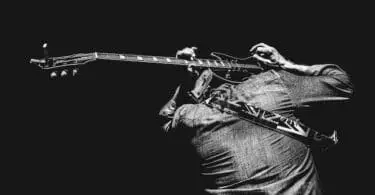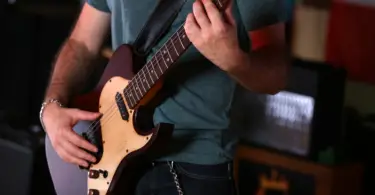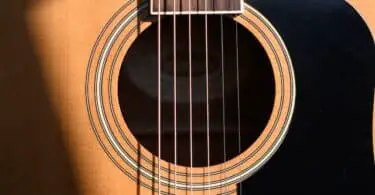The guitar capo is among the most common accessories that you will come across when using acoustic or electric guitars. The word capo means head in Italian, a small guitar tool that players clamp onto the guitar’s neck. This tool helps to shorten the length of the strings, allowing it to raise the guitar’s pitch.
In today’s post, you’ll learn everything you need to know about guitar capos, including why you need them, the different types, how to apply a capo, and many more.
Let’s get right into it!
Quick Links
Reasons To Use A Guitar Capo
Guitar capos help guitar players in many different ways. It shortens the vibration from open strings, allowing players to have better control.
Aside from that, it lets them change a song’s key while remaining in the standard open position. Know more reasons why you should have this attachment below:
Brighten The Tone Of The Guitar
Attaching a capo high enough on your guitar’s neck will produce a brighter sound close to a mandolin. Guitar capos are also incredibly useful for two guitarists playing together as they can create variations between the musical instruments’ timbre. As a result, it produces a striking effect for both players.
You can often witness this kind of technique being used by folk-guitar players. Aside from its striking effect, it also creates a very intricate guitar sound.
Changes The Key Of The Song
Most guitar capo users are guitar players who accompany singers or those who also sing. The reason is that this guitar attachment allows the guitarist to play any chords they are familiar with, even when they need to play a different key.
Imagine how helpful it is when the player wants to skip bar chords or chords that are less familiar to them. For instance, when the guitarist is not comfortable playing E-flat, a complex guitar chord, the player can attach a capo to switch the string’s tuning. It will allow the use of basic open-position chords while having the same sound as the E-flat key.
Leaves Your Finger Less Sore
The advantage of playing in the guitar’s higher-up neck is that it is easier on the fingers. You will need less pressure to fret a note at the guitar’s 6th fret than the 1st fret.
Using a capo at the first fret won’t require much pressure to press a guitar chord as you don’t have to move or stretch your fingers a lot. Overall, it will allow you to play guitar chords in a more relaxed state.
Helps Songwriting And Composition
If you are passionate about writing and composing a song, one of the guitar accessories that can make things easier for you is a guitar capo. This attachment will allow you to use chords from an existing song and make it unique and totally unrecognizable.
For example, you can play the song Let it be by the Beatles using guitar chords G, D, Em, C with a capo on the 5th fret. If you place the capo to the 1st fret, these chords will sound quite different.
Another way to make it sound unique is to change the strum pattern. Every little thing you change when playing these chords can make the sound even more unrecognizable.
Making The Song Sound Better
A guitar capo can also improve the sound of a song, even if the existing arrangement of the original song is perfect. Sometimes, incorporating the guitar chords alone won’t produce the sound you are opting for. This could be because the original arrangement doesn’t involve a guitar, so the chords don’t fit right.
To fix this, you can use a guitar capo and change the guitar chords. Doing so can help the sound blend and make it beautiful while still using the same key.
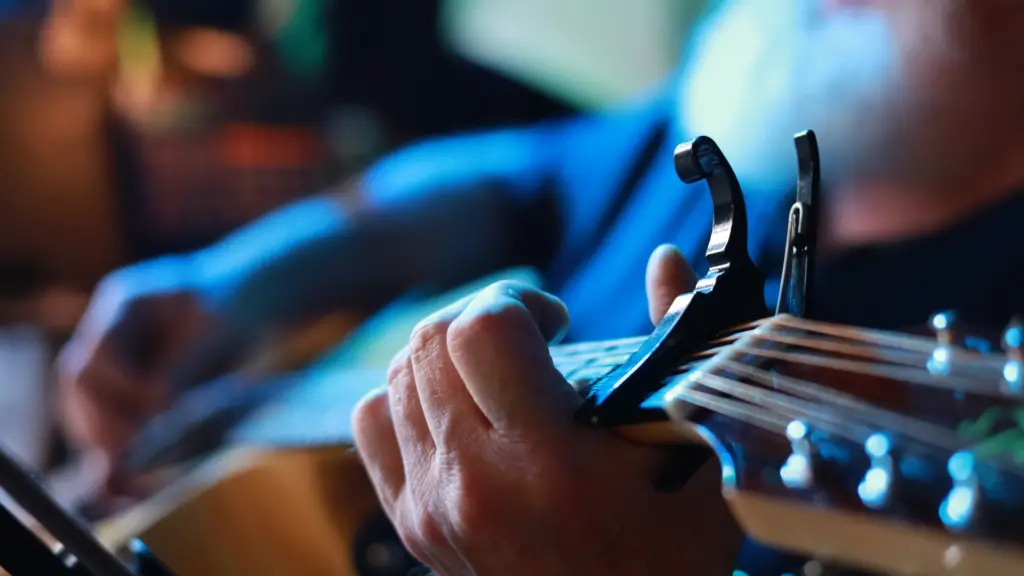
Types Of Guitar Capos
Assuming that you have decided to get a guitar capo, here are some of the types you can choose from:
1. Trigger Capos
Also known as spring capo, a trigger capo will let you easily and quickly change the key with a squeeze of the hand. It has a spring-action clamp that keeps the capo in place and has a slim profile that allows it to play up and down the fingerboard of your guitar unhindered.
Most trigger capo also has special padding that protects your guitar’s neck from scratches. You can find this type of guitar capo available in aircraft-grade aluminum and other sturdy materials.
On the other hand, some guitarists are not satisfied with the tension it provides. Since it only utilizes a spring-action clamp, its tension is non-adjustable.
In some cases, the tension of the capo is a little weak, leading to fret-buzz issues. When it is too strong, the guitar strings might over-bend and result in tuning problems.
Trigger capos are generally cheaper compared to other types. Aside from that, they are easy to use and are excellent for beginners.
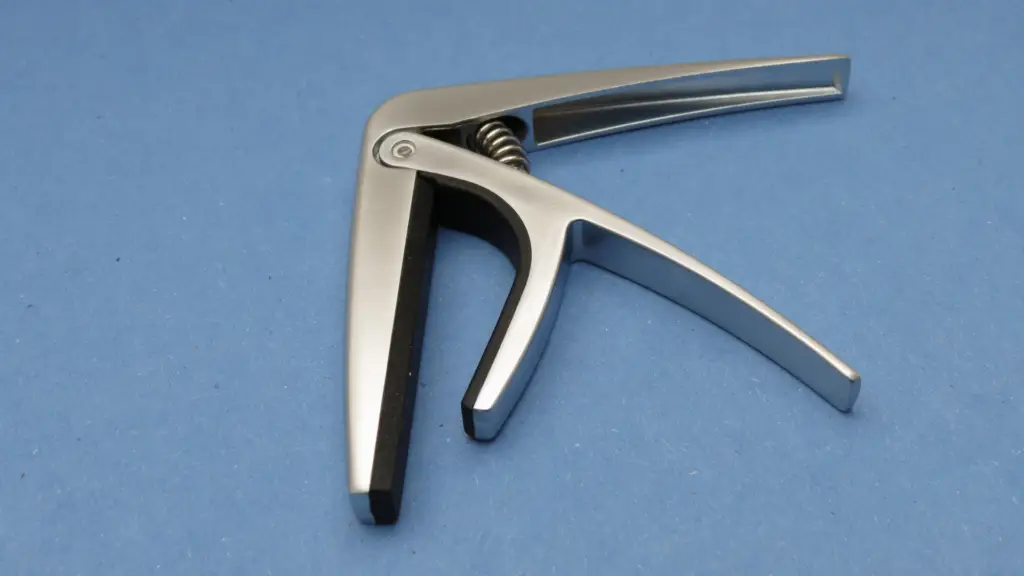
2. Screw Capos
Another type of guitar capo is the screw capo. It addresses the issue of trigger capos regarding tension as it has an adjustable mechanism, allowing you to fine-tune the pressure it puts against the guitar strings.
With its adjustable screw, you can set the perfect tension of the capo regardless of your guitar’s fret neck size, string action, fret position, and many more variables you might encounter. However, this type of guitar capo also has its flaws.
Unlike the trigger capo, a screw capo takes more time to place and reposition. As you can imagine, you have to loosen the tension on its screws each time you have to move it.
Screw capos are not ideal for using on-stage as it could be awkward to reposition during a performance. Since you have to rush, it could also lead to poorly set guitar tensions. But despite these shortcomings, most guitarists still love using screw capos.
3. Roller Capos
The least popular among the types of capos are the roller capo. The main advantage of this guitar capo is that it is easy and fast to reposition. You can slide it up and down your guitar’s neck, just like how trigger capos work.
Aside from that, roller capos are easy to remove. You only have to slide it over the nut to play open-string.
Roller capos also have wider fretting pressure that allows less issues when it comes to tuning. However, its tension is non-adjustable, too, just like the trigger capo.
Another drawback that you may encounter when using roller capos is that they have a lot of metal surface that might scratch your guitar. They also have a limited neck size that might not fit 12-strings and classical guitars.
For beginners, this type of guitar capo might not be the best choice. But, unless you try it, you will never know if you will love its unique features.
4. Toggle Capos
If you want the simplest type of capo, opt for toggle capos. They come with an adjustable strap that holds its tension, and these straps are incrementally tightened on the back of the bar along with several notches.
Many guitarists like using these types of capo as they are light and small. In fact, you can barely see them as you play.
You might be wondering why not so many players use them. Here’s the reason why. Despite their advantages, toggle capos generally have the most problematic design.
First of all, the ideal tension of the strap often lies somewhere between two notches. So, when securing it over the neck, one of its notches is too loose while the other is too tight.
When the tension is perfect, the strap still loosens and stretches over time. You have to add a half-twist to the capo’s strap as necessary to shorten its length a little and solve this issue.
However, doing this constantly could eventually lead to breakage. Good thing that a toggle capo is super cheap.
5. G7th Capos
G7th capos solve most of the major issues associated with the capos mentioned earlier. First, G7th capos don’t attract too much attention while you are playing. They don’t have any awkward levers or bars that will get in your way.
Also, they won’t cause damage to your guitar. G7th capos don’t have sharp, metal edges, and they feature a rubber lining on the inside.
They also let you adjust the tension easily with one squeeze. Its design is quite similar to trigger capos that automatically lock in place like a clamp.
Another thing you will like about this style of capo is that they are easy to move. They also do an excellent job in preserving tone, which is among the best advantages it offers.
The only thing that some guitarists don’t like about G7th capos is their heavier construction. But, overall, this type of guitar capos is an excellent choice.
6. Shubb Capos
Back in the 1980s, Shubb C1 was developed. It integrates a simple lever that you can adjust for tension and flip easily on or off.
Basically, Shubb capos have a design that incorporates both the speed of a trigger capo and the precision of a screw capo. It also comes with a unique rubber contact surface that prevents tuning issues through a broader fretting surface, which copies how a human finger works when fretting.
7. Partial Capos
Guitar players rarely use this type of capo to make sounds that are not usually possible to create on a standard guitar. They are excellent for increasing the possibilities when coming up with new drone combinations and chords and are ideal for guitarists who love open tunings.
Frequently Asked Questions About Guitar Capos
Will A Capo Damage Guitar Strings?
No, a guitar capo will not damage the strings of your guitar. The tension imposed by capos on guitar strings is not enough to cause breakage.
However, too much tension on guitar strings can damage them. They might break when you over-tighten strings, which is only possible to happen when guitar tuning.
Are Capos Bad For Guitar Frets?
Some capos do. As mentioned earlier, particular types of guitar capos might cause damage to the frets of your guitar. In fact, some guitarists chose not to use capo as they didn’t want to risk their frets.
Unlike guitar strings, frets are quite expensive to replace. For this reason, some guitar players stay away from guitar capos.
Capos have the possibility to wear out guitar frets faster. Since capos lessen the action on guitars, the guitar strings become close to the frets.
As a result, there’ll be more friction between the frets and strings when you play. It could cause the frets to become damaged and wear out.
Tips To Prevent A Capo From Damaging Your Guitar
Below are among the ways you can reduce the risk of damage imposed by a guitar capo.

Take Off Your Capo After Use
As mentioned earlier, certain types of guitar capos could cause damage to your guitar frets. So, it is best to make it a habit to remove the capo on your guitar after use.
Use Proper Strumming Technique
The way you strum your guitar could also contribute to fret damage, and it is especially true when there is a capo attached to your guitar.
When your guitar frets often require some repair, start learning the proper way to strum your guitar with a capo on. Doing so helps to reduce the damage taken by your guitar frets and improve the sound your guitar produces.
Some Final Words
Overall, a guitar capo is considered an essential accessory for every guitar player. Some capos are relatively cheaper than others, but your budget should not be the main determining factor when choosing the appropriate guitar capo for you.
With the varying types of guitar capos mentioned earlier, make sure to choose the one with a design and features that work best for your style and needs. Each type has its own set of perks that could help to improve your performance.

